
A kayaking Expedition to the Far East: Planes, trains, and automobiles to
the most Remote corner of India.
Destination: The restricted Indian state of Arunachal Pradesh.
By Rafa Ortiz and Ben Stookesberry
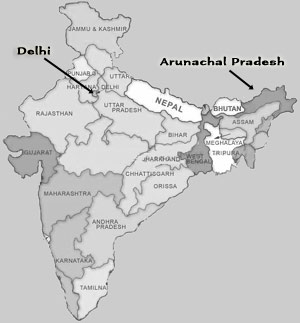

A kayaking Expedition to the Far East: Planes, trains, and automobiles to Destination: The restricted Indian state of Arunachal Pradesh. By Rafa Ortiz and Ben Stookesberry |

|
Most people choose to travel to big destinations, popular tourist sites, and cities relatively close to their point of entry. In contrast, Ben and I would be traveling as far from the transportation Mecca of Delhi as possible, to the distant Northeastern state of Arunachal Pradesh.
Arunachal Pradesh ( Hindi for 'State of the mountains first lit by the sun' ) is the most spectacular and difficult destination in the Indian sub-continent. First, it contains the Southeastern front of the Himalayas, which are some of the largest mountains on earth. With this kind of massive topography, traveling even short distances can take forever. Second, Arunachal contains a half dozen big water rivers with a minimum flow of 10,000 cfs that converge to form the mighty Brahmaputra.
This means that on top of the windy roads, you can add sketchy ferry crossings, washed-out bridges, and crater-laden roads to an already excruciatingly long journey. Arunachal Pradesh is also the most restricted region in India, which adds yet another layer of complexity.
The far northeast corner of India has seen only a handful of paddling expeditions, so there are many rivers that have never been run. However, due to travel restrictions, the only way to enter Arunachal is to pay a local tour operator exorbitant amounts of money ( at least a month in advance ) for a regulated ten-day tour. Ten days was not nearly enough time for us to explore the rivers of this area, so this was the first obstacle that had to be overcome.

We were able to secure both the logistical arrangements and the necessary permits that made our journey possible ( and affordable ) thanks to Roland Stevenson of River India ( www.riverindia.com ). Ben had met Roland during a fourth of July party in Oregon the previous summer. During a conversation frequently interrupted by the explosions of fireworks and the screams of fellow party goers, Roland had convinced Ben to branch away from his Latin American travels and take an epic journey to the far east.
Luckily for us, Roland ( who speaks five languages ) pulled some strings with Arunachal's minister of tourism and so we were able to get a trip extension to paddle in the restricted area of Arunachal Pradesh.
After a two-day flight, Ben and I found ourselves in a seedy downtown Delhi hotel. Our brief sleep that night was merely a snack for our jet-lagged bodies as we rose early the next morning to begin our long trek to the Himalayas.
|
We left the hotel in a couple of bike-Rikshaws holding on to our boats and luggage while the mighty drivers pedaled through the dense market traffic. It was a hectic scene, with people, dogs, cars, cows, trucks, food stands, and Rickshaws all singing, crying, barking, honking, mooing, or shouting to avoid getting hit by others.
The density of sight, smell, and sounds of Delhi made Mexico City seem like a sleepy little town. After a couple blocks, we finally made it to the train station. Getting kayaks on a train in India is not an easy matter. Roland had to bargain here and there, moving constantly from person to person in pursuit of the right combination of paperwork and people to get the job done. Finally, after three hours, we were able to load the kayaks and board as the train started to roll. At this point we were joined by Rolands friend and kayaker Kevin Thompson, who added good humor and knowledgeable insight to our trip. Roland opted to fly on ahead, covering in a few hours what would take us several days by train. As the train rolled through the flat Indian countryside, an endless expanse of rural humanity rolled past our window. With a billion inhabitants, it was nearly impossible to get a photo without at least one person in it. Yet from the comfort of our second class accommodations, meals and snacks every hour made the trip more the bearable, with long hours of sleep and naps between meals. One morning I opened the door of the train just after a foggy sunrise to get some fresh air. The air was thick with morning moisture, but there was also a rather unpleasant smell. The source of the smell soon became evident as Indians emerged from every direction to do their morning duty on the tracks. We found out later that the tracks are public property and thus used as an open-air latrine by the locals. |
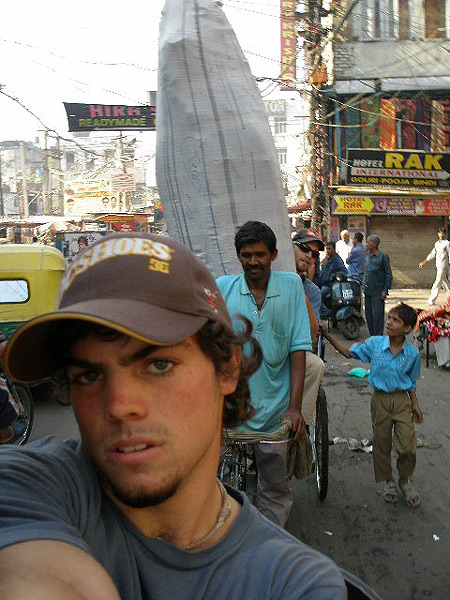
|
Thirty hours after departing from Delhi we arrived in Guwahati, Assam, the last true urban outpost on Indiaís Northeastern frontier. Roland met us at the train station with Vipin Sharma, a local whose knowledge and good spirits would prove vital in the long journey ahead. It was dark so we got a hotel, which provided a nice curry dinner and some great Indian rum.
A happy dog at the train station.
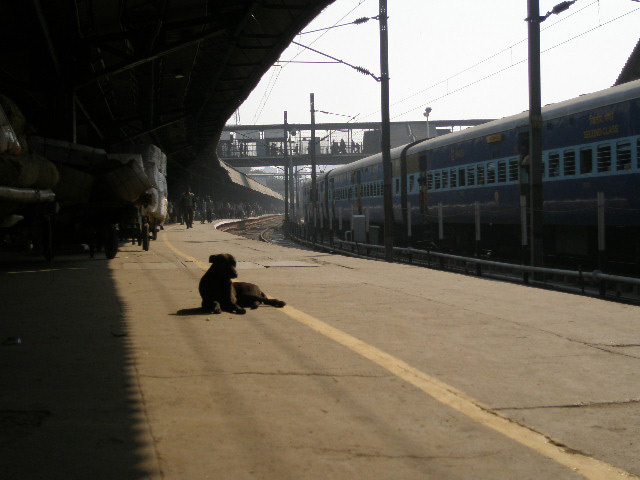
At this point we had fifteen hours of driving to reach our first river so we wanted to leave early. Of course, what you want to do in India and what you actually do are often two very different things..
The next morning we learned that our driver had canceled at the last minute because our particular mixture of Karma, Dharma, and strange looking river craft was just not right. Fortunately, only three hours later we were on our way with a new Jeep and driver that eagerly blessed our expedition with hot cups of chai tea.
This is when the real adventure began.
Again I was overwhelmed by the sheer humanity of the place as our driver sped through the seemingly impenetrable mass of cows, dogs, chickens, pigs, elephants, pedestrians, road crews, and oncoming traffic.
Seven hours and two hundred miles later we crossed the seven kilometer-wide flood plain of the Brahmaputra River. India shares the northern hemisphere with North America, so it was almost winter now and the monsoon rains hadn't fallen for over a month. The river was only flowing in a fraction of its massive bed, but it still had two channels that were over a mile wide. However, unlike the majority of North America, Indias latitude is similar to that of Florida, so the lowland climate is very hospitable.
From the river crossing it took us another two hours to reach the border of the restricted state Arunachal Pradesh, where the road starts to ascend into the Himalayas.
We were about thirty kilometers from the mountain town of Bomdila ( 8,500 feet ) when we encountered one of the many police check points along the road. Our driver kept going past the "STOP" and "GO SLOW" signs until we reached a barricade. A furious policeman burst out of his little hut, cursing loud and fast in an unintelligible mixture of Hindi and Assamese while gesturing for us to back up.
With no hesitation, the driver put it in reverse and gave it some gas. They say in India that everything bad or good happens because of karma, so I guess it was karma that caused our tire to roll over the policeman's foot, which had him limping and us laughing. Next thing we knew, our Karma had us spending the night in the police station with our driver behind bars and our jeep impounded..
Our driver probably should have stopped when the signs said 'stop'..
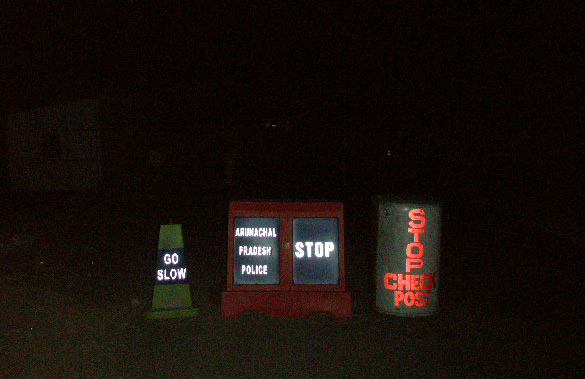
The next morning there wasn't much we could do for our driver other than call his boss to bail him out. After that was accomplished, it only took an hour to find another vehicle and a driver willing to continue the journey.
Bomdila was only a near vertical hours drive above our unplanned overnight stay at the police station so we had lunch there then pushed on to the put-in at Dirang. After our seemlingly endless journey to the river, Ben and I were eager to start our first river expedition in this vast country. When we arrived at the river the last light was draining from the sky, but we decided to put on anyway. We packed for at least three nights, which seemed sufficient for a 100+ mile descent of the Dirang Fork into the Kameng river.

The Dirang is a tributary for the Kameng, which itself is a tributary of the Brahmaputra. The Dirang headwaters emanate from the second largest Bhuddist monastery in the world on the border of Bhutan, in the eastern reaches of Arunachal.
According to Rolandís information about previous descents of the Kameng, only the main Kameng itself had been run. We wouldn't enter the Kameng until nearly halfway into our planned journey, so we had approximately sixty miles unexplored river below us.
We attracted a little attention at the put-in. The kids loved our kayaks..
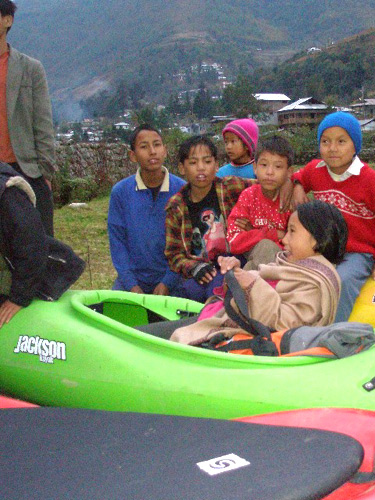
We begin the trip with a thousand cfs of crystal clear water in near darkness. The goal was to get as far out from town as possible, hopefully finding a nice beach for our first campsite. After an hour in darkness and the sketchiest two kilometers of class 2-3 that I have ever run, we found a nice deserted beach to camp on.
Our camping spot seemed perfect until we discovered that there were sheepherders and their flock are camped on the slopes directly above us. We ate and some biscuits and rum for dinner under the clear and peaceful sky, with sleep following soon after.. Or so we thought. Throughout the night, the herders managed their flock with bone chilling screams and sharp whistling. After awhile we began to wonder if this was meant for us or the flock.
The next morning we were greeted by two very Tibetan-looking boys whom we later found were part of the Monpah tribe of herders. The warmth and friendliness of these people was overwhelming as they started our fire, and offered us steaming hot cups of tea.
In the morning light we were able to survey our surroundings and found a beautiful Tibetian valley which took center stage as dawn broke on the pine-laden hillsides. After breakfast we said goodbye to the kids and put on the river, which had some amazing whitewater.
Rafa runs a drop I dubbed 'boulder sluice' after it's similarity to the drop on the Little White.
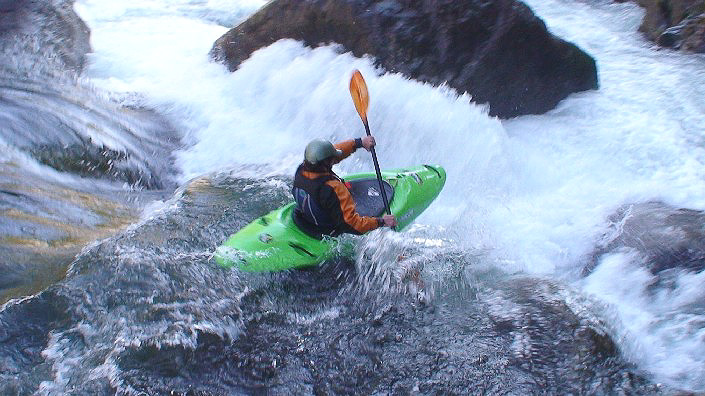
In the subsequent three days we descended a through a myriad of landscapes from our pine forest Tibetan put-in, to the monkey-infested bowels of the lower Kameng.
Rafa on a typical dirang rapid.
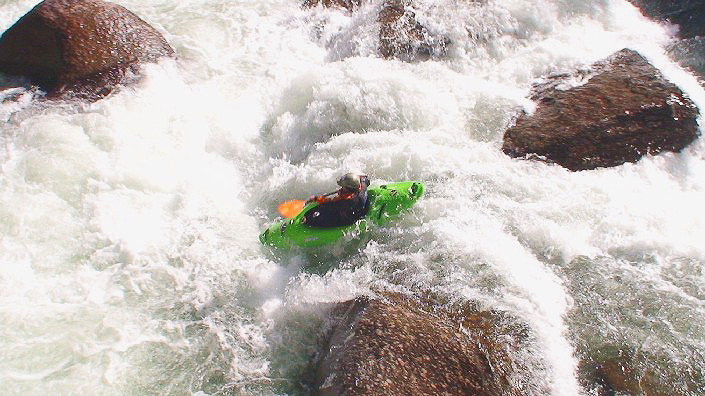
The whitewater was of similar diversity with everything from technical boulder gardens and bedrock ledges to the big water waves and holes of the main Kameng. All of this was incredible whitewater up to class V in difficulty.
For three solid days we put in around 10 hours of non-stop paddling per day; starting with the first hours of light and finishing just after sunset. In all, we paddled around 110 miles of River from Dirang to Balukpong, making this the longest stretch of whitewater that either Ben or I had ever run that was until later in the trip.
Ben fires up a big one..
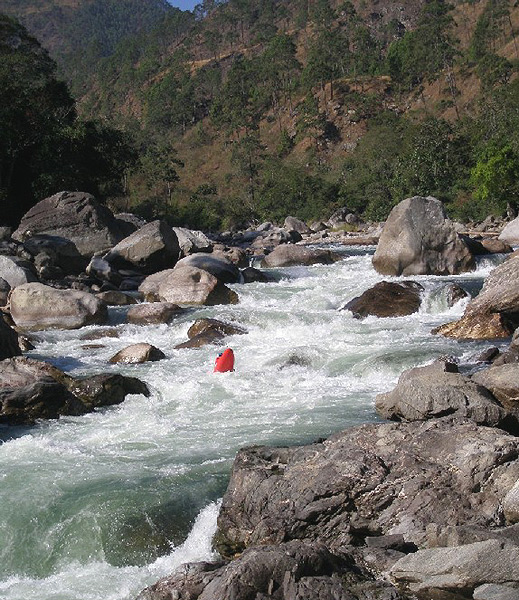
Back on land, we were happy to meet again the land crew that had grown significantly: Roland, Vipin, Kevin, Ben and I were now joined by a master of whitewater photography ( Lucas Gillman ), his girlfriend / assistant ( Sarah ), and a entourage of Arunachal locals and guides from the Donya Hango Tourism concern. At the end of the month these local guides would be participating in Rolandís non-profit Sarsi guide school over the new year, and were therefore interested in seeing some kayaking on their rivers (sarsi.riverindia.com).
After a nice meal and some super strong Indian beer we were all ready for our next quest: exploring the waters of the lower Tsangpo in India: the Siang River Expedition.
Ben Stookesberry and Rafa Ortiz in India
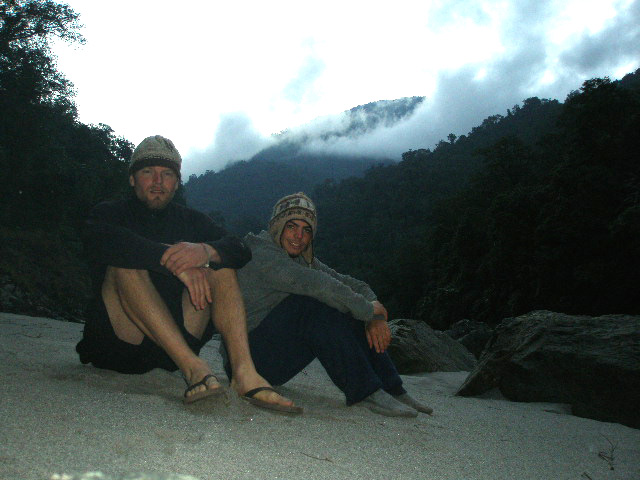
Stay tuned for Rafaís next chapter of the Journey and Benís upcoming whitewater epic, Hotel Charley Vol. 2: The River of Doubt. Ben and Rafa are both members of the Jackson Kayak Team.